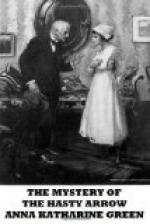But nowhere in the great city of which we write on this night of May 23, 1913, was there to be found a scene of greater contradictions than in the court and galleries of its famous museum.
Lighted as for a reception, the architectural beauties of its Moorish arcades and carven balustrades flashed in full splendor. Gems of antique art, casts in which genius had stored its soul and caused to live before us the story of the ancients, pillars from desert sands, friezes from the Parthenon and bas-reliefs from Nineveh and Heliopolis, filled every corner, commanding the eye to satisfy itself in forms of deathless grace or superhuman power. And no one to heed! Not an eye to note that the Venus in one corner seemed to smile in the soft light with more than its accustomed allurement, or that the armor in which kings had fought wore a menacing sparkle exceeding that of other times and quieter days. Ghosts of vanished ages might parade at will among the chattels of their time or drain the iridescent beaker to their unknown gods—no one would have noticed or turned aside to see. For there was something else within these walls to-night for the men assembled there to look upon, and a story to be read which shut the imagination upon the past by amply filling it with the present.
What is this something? Let us follow the gaze of the half-dozen persons grouped in front of the tapestry hanging in the northern gallery, and see.
But first, of whom is this small and mystic group composed? Who are these men who in the middle of the night, in the security of a completely shuttered building, busy themselves, not with the inestimable treasures surrounding them, but with an odd and seemingly mountebank adventure totally out of keeping with the place and their absorbed demeanor? We will name them:
Mr. Roberts and a second director seen here for the first time, Inspector Jackson, Mr. Gryce, two lesser detectives, and a strange young man of undoubted Indian extraction who kept much in the background and yet stood always at attention like one awaiting orders.
Are these all? Yes, in the one gallery; but in the other, shadowy figures are visible among the arches at one end, with whose identity we shall probably soon be made acquainted.
At what are these various persons, in the one gallery as in the other, looking so intently that all are turned one way—the way of greatest interest—the way the fatal arrow had flown some fourteen hours before, carrying death to the innocent girl smiling upon life in youthful exuberance? Is it at some image of herself they see restored to hope and joy? An image is there, but alas! it is but a dummy taken from one of the exhibits and so set up as to present the same angle to the gallery-front as her young body had done, according to Mr. Travis’ reluctant declaration.




